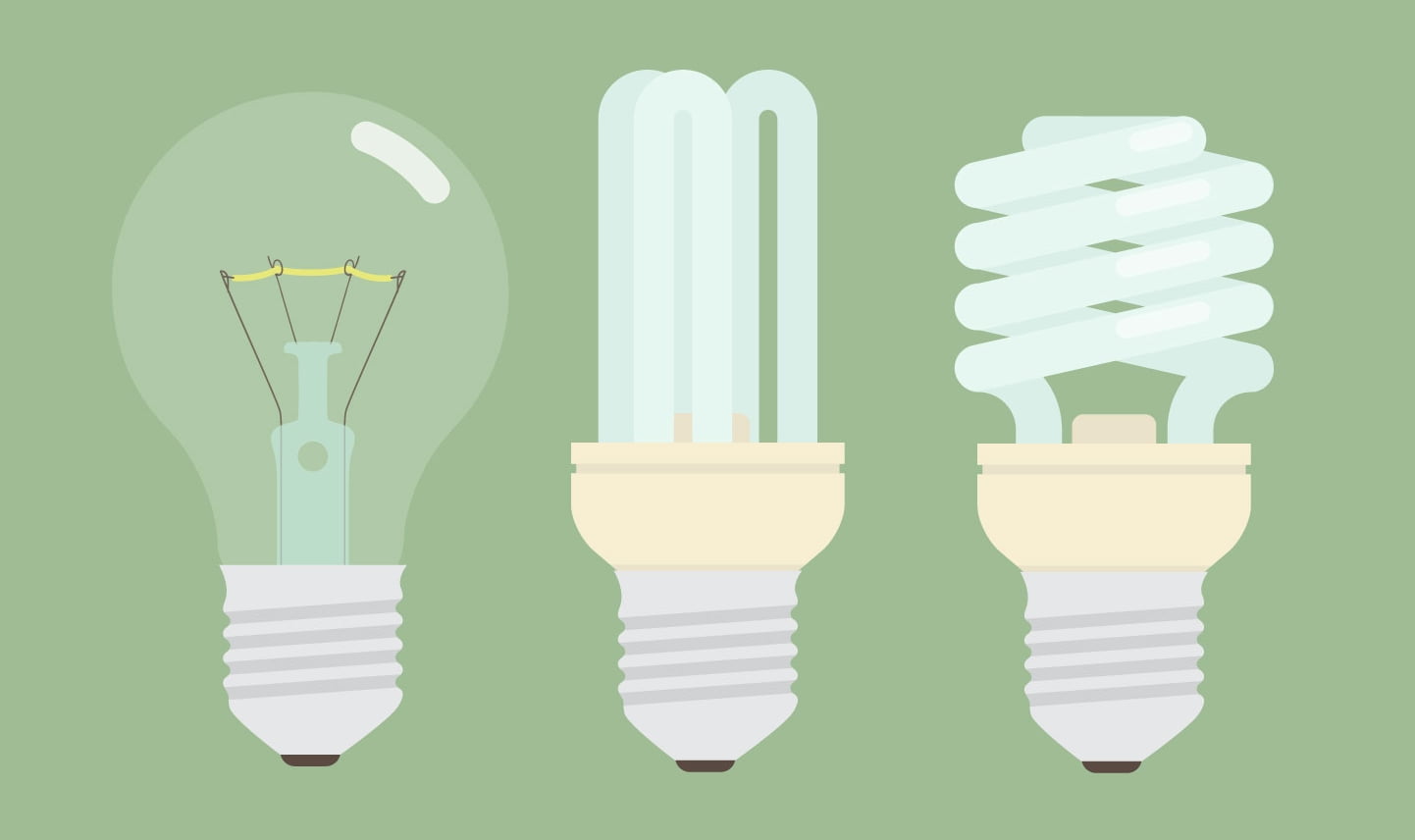What kinds of bulbs are available?
We’ve all gotten to know incandescents quite well over the past 135 years or so, but times are changing. These days, you’ve got some new lighting categories to familiarize yourself with, and doing so is the first, most obvious step toward buying the right bulb.
LEDs
Average cost: $3 to $20
Average wattage: 4W to 22W
Average life expectancy: 20,000 hours
Light-emitting diodes, or LEDs, are the new rock stars of the bulb world. When an LED is switched on, electrons and electron holes come together (and don’t worry, I’m not completely sure I fully understand what a “hole” is in this context, either). At any rate, the result of this process is a release of energy in the form of photons, or light.
A typical LED uses a fraction of the wattage required to power a bright incandescent bulb, and this makes LEDs dramatically more cost-effective over the long run. For instance, a 10W LED that puts out 800 lumens of light (lumens are units of brightness for a light source — more on that in just a bit) will add about $1.20 per year to your power bill if used for 3 hours a day at an average energy rate of 11 cents per kilowatt hour (kWh). Under those same parameters, a traditional 60W incandescent bulb that puts out the same amount of light will cost about $7.20 per year — that’s more than the cost of replacing it with a basic LED like the one described above. Multiply that by the total number of bulbs in your home, and you’re looking at the potential for some pretty significant long-term savings.
LEDs are also rated to last for tens of thousands of hours, which can translate to decades of use. Compare that with the year or so you typically get out of an incandescent, and you can begin to see why so many people find these bulbs appealing. With some options now as cheap as $3 per bulb, that 10W LED would pay for itself in energy savings within a few months, then keep on saving you money for years if not decades to come.
CFLs
Average cost: $2 to $20
Average wattage: 9W to 52W
Average life expectancy: 10,000 hours
Before LEDs exploded into the lighting scene, compact fluorescent lights (CFLs to you and me) were seen by many as the heir apparent to incandescent lighting. Despite the fact that CFLs use between one-fifth and one-third the energy of incandescents, and typically save one to five times their purchase price over the course of their lifetime, many people weren’t thrilled at the idea of switching over. Some find the whitish light output of CFL bulbs less aesthetically pleasing than the warm, yellow tone of most incandescents. Others are quick to point out that CFL bulbs that regularly get powered on and off for short periods of time tend to see a significant decrease in life expectancy. There’s also the common complaint that most CFLs aren’t dimmable, and that they often take a second or two after being switched on to fully light up.
The good news here is that CFL technology has improved a lot since EISA was signed into law 10 years ago. Today, you’ll find a greater variety of color options, including bulbs rated at the low, yellow end of the Kelvin scale, and you’ll have an easier time finding dimmable CFLs, too. There are even “instant-on” CFL bulbs designed to eliminate that annoying delay between flipping the switch and seeing the light.
The bad news is that in spite of these improvements, CFLs remain somewhat flawed. They’re still prone to decreased life expectancy when you use them in short increments, so ideally you’ll want to save them for lighting that you’re going to keep on for longer periods of time. Additionally, most CFLs aren’t intended for outdoor use, and some will fail to turn on in colder temperatures — although if you shop around, you can find cold-cathode CFL bulbs rated for temperatures as low as -10 degrees Fahrenheit.
Incandescents
Average cost: $1 to $10
Average wattage: 40W to 150W
Average life expectancy: 1,000 hours
When I tell you to picture a light bulb, chances are good that you’re envisioning an incandescent. This is the classic bulb of Thomas Edison: a tungsten filament trapped within a glass enclosure. Electricity heats the filament to a point where it glows, and voila, you have light.
Halogens
Average cost: $2 to $15
Average wattage: 29W to 72W
Average life expectancy: 1,000 hours
Halogens are just incandescent bulbs with a bit of halogen gas trapped inside with the filament. This gas helps “recycle” the burned-up tungsten gas back onto the filament, making for a slightly more efficient light. Unlike the mercury in CFLs, this gas isn’t anything that could be classified as hazardous waste.
Due to their relative similarity to classic incandescents — both in light quality and in cost — halogens can work as a good compromise bulb for consumers who need to replace their incandescents, but who also aren’t ready to commit to CFLs or LEDs quite yet.
Lumens
If you’re buying a bulb these days, you’ll be left in the dark if you don’t know what a lumen is. The actual definition gets a bit complicated, involving things like steradians and candela, but don’t worry, because all that you really need to know is that lumens are units of brightness. The more lumens a bulb boasts, the brighter it will be. So, how does this information help you?
Let me give you an example. If you look at CFL or LED bulbs, you’ll see that most all of them are marketed as “replacements” for incandescent bulbs of specific wattages. You’ll probably see the word “equivalent” used, too, as in “60-watt equivalent.” This can be frustratingly misleading, because watts measure energy usage, not brightness, and “equivalent” often means something closer to “equivalent… ish.”
Relying on these wattage equivalencies can lead you to buy a bulb that ends up being far too dim or too bright for your needs, and this is where understanding lumens really comes in handy. With lumens listed on each and every bulb, you’ll always have a concrete comparison of how bright any two bulbs actually are. The bigger the lumen count, the brighter the bulb — easy enough, right?
How many lumens do I need?
Over the last century, we’ve been trained to think about light purely in terms of wattages, so it isn’t surprising that most people really have no idea of how many lumens they actually need in a bulb. Until you form an idea of how bright is bright enough for your tastes, stick with these figures:
Replacing a 40W bulb: look for at least 450 lumens
Replacing a 60W bulb: look for at least 800 lumens
Replacing a 75W bulb: look for at least 1,100 lumens
Replacing a 100W bulb: look for at least 1,600 lumens
Color temperature
After lumens, the next concept you’ll want to understand is color temperature. Measured on the Kelvin scale, color temperature isn’t really a measure of heat. Instead, it’s a measure of the color that a light source produces, ranging from yellow on the low end of the scale to bluish on the high end, with whitish light in the middle.
An easy way to keep track of color temperature is to think of a flame: it starts out yellow and orange, but when it gets really hot, it turns blue. You could also think of color temperature in terms of the sun — low, yellowy color temperatures mimic the tone of light at sunrise or sunset, while hotter, more bluish-white color temperatures are more akin to daylight (sure enough, bulbs with color temperatures like these are commonly called “daylight” bulbs). This is also why a lot of people prefer high color temperatures during the day and lower color temperatures in the morning and evening.
Generally speaking, incandescents sit at the bottom of the scale with their yellow light, while CFLs and LEDs have long been thought to tend toward the high, bluish end of the spectrum. This has been a steady complaint about new lighting alternatives, as many people prefer the warm, familiar, low color temperature of incandescents. Manufacturers are listening, though, and in this case they heard consumers loud and clear, with more and more low-color-temperature CFL and LED options hitting the shelves. Don’t believe me? Take another look at those two paper lamps in the picture above, because they’re both CFL bulbs — from the same manufacturer, no less.
These days, bulb shoppers will find so many color temperature options that some lighting companies have cleverly begun color-coding their packaging: blue for high-color-temperature bulbs, yellow for low-color-temperature ones, and white for bulbs that fall in between. With so many choices available, the notion that the phase-out of incandescents is taking warm, cozy lighting with it is a complete myth at this point.
Color rendering index
Unless you live in a disco, you probably want the colors in your home to look somewhat traditional. This is where the color rendering index, or CRI, comes in. The CRI is a score from 1 to 100 that rates a bulb’s ability to accurately illuminate colors. You can think of the CRI as a light bulb’s GPA for colors, as it actually averages multiple scores for multiple shades. Manufacturers aren’t required to list the bulb’s CRI number on the packaging, but many of them choose to do so anyway, so you’ll want to know what it means.
To understand CRI a little better, let’s imagine a basketball game played outdoors on a sunny day between a team in red jerseys and a team in green jerseys. Daylight is the ideal for making colors look the way they should, so it gets a CRI score of 100. Most people watching this game would have no problem telling the teams apart, because red would appear clearly red, and green would look green.
Now let’s imagine that same basketball game — except now it’s being played inside that disco I mentioned earlier. We’re indoors, it’s a little dim, and we’re stuck with multicolored spotlights as the only light source. A purple one shines down on a very confused point guard as he takes a shot. Can you tell if he’s on the green team or the red one? I wouldn’t be surprised if you couldn’t, because the CRI score of lights like those is abysmal.
Now here’s the rub: the CRI is highly imperfect and not always useful (the reasons why are mind-numbing, but you can read more here if you’re curious/masochistic). The important takeaway is that CRI scores are really only helpful if you’re talking about bulbs that sit in the middle of the color temperature spectrum. You’ll probably see references to “white” or “natural” light on bulbs like these. In these cases, the CRI score can be a great way to tell a good bulb from a great bulb.
In general, anything over 80 is probably decent enough for your home, but we’re starting to see CRI scores creeping up into the nineties on some very affordable bulbs. The GE Reveal BR30 floodlight LED won our Editors’ Choice distinction for its emphasis on color rendering. There’s even a $5 LED from Ikea that scores in the upper 80s. If accurate color rendering is important to you, look for lights like these. And if you’re buying bulbs on the high (blue) or low (yellow) end of the spectrum, take any and all CRI claims with a grain of salt.
How do I tell if a light bulb is efficient?
In simple terms, a light bulb is just a device that converts electricity into light. The more lumens of light you get per watt of electricity, the more efficient the bulb is. With incandescent bulbs, efficiency is easy to understand because a specific wattage of electricity will always heat a tungsten filament to a specific temperature, which in turn will yield a specific level of light. This means that, generally speaking, one incandescent will be more or less as efficient (or by today’s standards, inefficient) as another.
With LEDs and CFLs, the bulbs still convert electricity into light, but the methodology is totally different. Light output isn’t fixed to the temperature of a filament, which means there’s more wiggle room for differences in efficiency. Simply put, unlike incandescents, LED and CFL bulbs are decidedly not created equal.
This is another place where it’s essential to understand lumens. A 10W LED can easily outshine a 12W competitor if it converts watts into lumens more efficiently. All the wattage tells you is how much power the bulb uses. The lumens tell you how much light the bulb puts out. The ratio between the two tells you how efficient the bulb is. The more lumens you’re getting per watt, the better the bulb is at converting electricity into light.
What other factors will I want to consider?
So far, we’ve covered the light bulb basics (and then some), but if you really want to get picky about your home lighting, or if you just want to delve a little deeper into the subject, there’s a lot more to take into consideration.
Bulb shape
As you’re probably aware, light bulbs come in a fairly wide variety of shapes. Sure, it’s easy enough to tell a hardware store clerk that you want “one of those flamey-looking lights,” or “just a normal ol’ bulby light bulb,” but knowing the actual nomenclature might save you some time.
Let’s start with the base of the bulb, the part that screws in. In the US, the most common shape by far is E26, with the “E” standing for Edison and the “26” referring to the diameter of the base in millimeters. You might also see E27 bulbs from time to time, which is the European standard. Those should still fit into common American fixtures, but keep in mind that voltage ratings are different in the two regions, with American bulbs rated for 120 volts compared to 220-240 volts in Europe. For smaller sockets, like you might find with a candelabra, you’ll want to look for an E12 base.
As for the bulb itself, the typical shape that you’re probably used to is an A19 bulb. Increase that number to A21 or A23, and you’ve got the same shape, but bigger. Bulbs made to resemble flames are F-shaped, which is easy enough to remember, as are globes, which go by the letter G. If it’s a floodlight you want, you’ll want to look for “BR” (bulging reflector) or “PAR” (parabolic aluminized reflector). Those bulbs are designed to throw all their light in one direction only, which makes them useful for spot lighting, overhead lighting and the headlights in your car.
Dimmability
A majority of modern lighting options now include compatibility with in-wall dimmer switches, and that’s a good thing for anyone who likes the light down low. If this sounds like you, then you’ll want to double check that your bulb’s packaging says the word “dimmable” before you make a purchase.
That said, some bulbs will dim down better than others — and your mileage may vary depending on what switch you’re using, too. Most basic switches dim the light by flashing the power on and off faster than the eye can detect. In many cases, this can cause electromagnetic interference in the bulbs, which can lead to flickering light or a faint buzz from within the bulb.
Which LEDs flicker the least? (pictures)
We also test out the dimmable range of each bulb we review — some can dim down lower than others before cutting out to black, and some won’t quite shine at full brightness with the switch dialed all the way back up. You’re probably nitpicking at that point, but hey, sometimes mood lighting matters.
If you’re truly focused on lights that dim well, then you may want to consider a smart LED kit. With an LED-specific dimming mechanism built right into each bulb, there’s no need for a dimmer switch. Instead, you’ll dim the bulb using a smartphone app, a physical remote accessory, or even a voice command if it works with Siri, Alexa, or the Google Assistant. Best of all, you shouldn’t encounter any buzzing or flickering. And hey, while we’re on the subject…
What about smart lighting?
It’s out there, it’s more affordable than you might think, and your options are growing quickly. Whether you want an elaborate network of fully automated lights, smart color control, or just a simple bulb that you can program over your phone via Bluetooth, you’ll find a growing number of options available from a variety of different sources.




